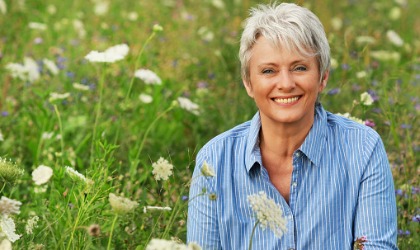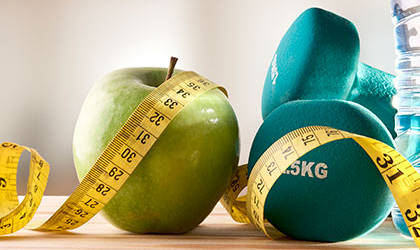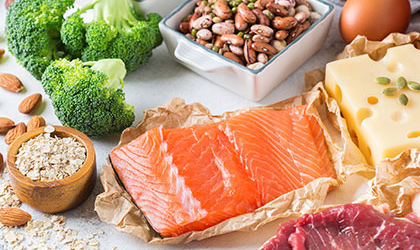Hot flushes and night sweats are the most common menopause symptoms, affecting around 80 per cent of postmenopausal women (i). The feeling of a hot flush needs no introduction to those who’ve experienced it. But for those who haven’t, hot flushes are often described as a feeling of intense heat rising from your chest up towards your head (though a flush can spread throughout your body). This heat can hardly be described as pleasant or even comfortable, and for some women it can be almost unbearable.
As well as feeling hot, areas of your skin – usually the chest, neck and face – may look visibly red and you may feel yourself perspiring. It’s also not unusual to experience palpitations when you have a hot flush. Then once the sensation subsides, you may feel cold and weak. Meanwhile, some women who have hot flushes find they’re so mild that they aren’t at all bothersome.
Duration and frequency
Most women are thought to experience a greater number of menopause-related hot flushes during the first year after having their last period (i). But while some women have hot flushes for just a few years, others have them for 10 years or longer (some find they’re still having hot flushes in their 70s or even 80s) (ii).
The duration of a hot flush can vary considerably from one woman to the next too. For some, they last for just a few seconds. But others feel hot for several minutes. Experts from Harvard Medical School also say some women have up to 20 hot flushes a day, while others may just have a few a year (iii).
Most of the time, hot flushes happen without any warning. But certain things can trigger one too, including stress, eating spicy food, drinking alcohol or coffee, taking certain medicines and wearing warm clothes. Occasionally, hot flushes can also be a symptom, not of menopause, but of premenstrual tension.
What causes them?
Experts still can’t agree on what causes menopause-related hot flushes. Most believe they are caused by hormone changes, particularly the low levels of oestrogen that affect women approaching and during the menopause. But low oestrogen may not be the only cause, since women of any age may have low oestrogen levels, yet they don’t experience hot flushes.
The role that oestrogen plays in hot flushes may be related to the effect it has on the hypothalamus – the part of the brain that regulates body temperature.
Some experts believe the fall in oestrogen levels confuses the hypothalamus, making it send signals to your brain that you’re too hot. The brain responds by sending out chemical messengers to make your heart rate increase and the blood vessels in your skin dilate to increase your blood flow. As well as making you feel hot, this makes you sweat – which is your body’s natural way of cooling you down.
However, the menopause isn’t the only thing that can cause hot flushes. Having an overactive thyroid (hyperthyroidism) can also trigger sensations of overheating, as can a rare condition called carcinoid syndrome. Some infections that cause a high temperature – such a s urinary infections – can trigger sensations similar to hot flushes too.
Some men can also have hot flushes if they’re having hormone treatment for prostate cancer. According to Cancer Research UK, hormone treatment may cause hot flushes in men by lowering the amount of testosterone in their bodies – though doctors need more evidence to confirm it (iv). Learn more about how menopause might affect your body.
Hot flushes: ways to cope
While HRT may be the most effective treatment for hot flushes and other menopause symptoms, there are other things you can do to help make life easier at this time in your life:
-
Eat as healthily as possible, making sure you include at least five portions of fruit and vegetables to your diet every day, as well as several portions of wholegrain foods to make sure you’re getting enough fibre. It’s also a good idea to limit the amount of foods you eat that contain saturated fats (red meat, full-fat dairy foods etc), and switching them for foods rich in monounsaturated and polyunsaturated fats (olive oil, avocados, nuts, seeds, oily fish etc).
-
Get plenty of moderate exercise – aim for at least 150 minutes each week (five 30-minute sessions, for instance). Not only will staying active help keep your weight down, it’s also thought to help reduce hot flushes and sweats (v). Exercise can also increase your production of hormones called endorphins, which may help boost your mood and make you copy with hot flushes more effectively.
-
If you smoke, now may be a good time to quit, as many experts believe smoking can make hot flushes worse (vi). Also try to drink less alcohol, especially if you find drinking makes you flush.
-
Other things that may trigger hot flushes include caffeine (tea, coffee, chocolate) and eating spicy foods. If you find they cause problems, try to limit these too.
-
Make an effort to get a better night’s sleep. Switch off by not watching TV or checking your smartphone too close to bedtime, and avoid having any caffeinated or alcoholic drinks before you go to sleep. If you’ve had a disrupted night because night sweats have kept you awake, try to make some time for a quick half-hour nap during the day.
-
If you’re too hot in bed – especially during the summer – don’t struggle with your duvet. Use just sheets or switch to a lighter duvet in the winter months. You could also try keeping your pillowcases in the fridge until it’s time to go to bed, or invest in a Chillow – a cool pad that goes on top of your pillow to keep your head, face and neck cool throughout the night.
-
Keep yourself cool in other ways too – wear clothes made from natural fibres that can help your body ‘breathe’, and dress in layers so you can easily remove the top one if you get too hot. Keep a portable mini fan or cooling facial spray nearby at all times so that you can cool yourself down whenever you need to. Also drink plenty of cold drinks – preferably with lots of ice – as they can help make you feel cooler.
-
Whenever you feel a hot flush starting, try to relax as much as possible. If you feel stressed or anxious during a hot flush, it’s likely to make things worse. Try sitting comfortably and inhaling through your nose while counting to four. Hold the breath for a second, then exhale through your mouth to a count of four. Rest your hands on your stomach and feel it rise when you inhale and fall when you exhale.
HRT basics
Hormone replacement therapy (HRT) is generally acknowledged as the most effective way to treat hot flushes. However many women try to avoid it, as it has been linked with several side effects, especially when taken in the long term.
Here are some of the things you should know about it.
The idea of HRT is that it replaces the hormones your body stops producing during and after the menopause. Most types of HRT contain two hormones – oestrogen plus a progestogen (progestogen is a man-made version of the natural hormone progesterone). The reason the two hormones are used together is that taking oestrogen on its own can increase your risk of endometrial cancer. Adding progestogen, on the other hand, reduces the risk of endometrial cancer. But if you’ve had a hysterectomy (where the uterus is removed), you may be advised to take a form of HRT that contains just oestrogen, as you have no risk of endometrial cancer.
There are various forms of HRT available, including tablets, implants, patches, gels and creams. Patches are popular as they release their hormones into your skin and through to your bloodstream, making them less likely to cause side effects than tablets. As with all these forms, there are several types available. Which type would be most suitable for you will depend on several things, including your age and your general state of health.
Risks vs benefits
If you have severe menopause symptoms, such as frequent hot flushes, you may feel the benefits of taking HRT justify you taking it. It is, however, a good idea to be aware of the risks before you make a decision:
Breast cancer
According to Cancer Research UK, taking any type of HRT increases your risk of breast cancer, with women taking combined oestrogen/progestogen HRT having the greatest risk (though the charity claims the increased risk is a small one) (vii) The longer you take HRT, the more your breast cancer risk increases. However, your risk returns to a normal level within five years of stopping taking HRT.
Ovarian cancer
Taking HRT slightly increases your risk of ovarian cancer, and again the longer you take it, the higher your risk. It can increase your risk of endometrial cancer too.
Stroke
If you smoke and are overweight as well as take HRT, your risk of having a stroke is increased slightly, says the Stroke Association (viii). This is why HRT isn’t usually recommended for women with a history of stroke or deep vein thrombosis (DVT).
Non-HRT treatments
For women who have troublesome hot flushes but can’t take hormone-based medicines, there are a few other options available:
Clonidine
Originally designed to treat high blood pressure, clonidine may also be useful in treating hot flushes – though according to the National Institute of Health and Care Excellence (NICE) there is limited evidence of its effectiveness (ix). It can also cause side effects such as dizziness, constipation, drowsiness, depression and water retention.
Antidepressants
Small doses of certain antidepressants such as ventlafaxine, paroxetine and citalopram are sometimes used to treat hot flushes. And while they aren’t licensed for treating hot flushes, some women find them useful. Again, however, there is a risk of side effects, including sleeping problems, anxiety, dry mouth, dizziness, loss of libido (sex drive) and nausea.
Gabapentin
This is a medicine used to treat epilepsy as well as nerve pain. However, according to information presented at the North American Menopause Society in 2012, it may also be useful for menopausal hot flushes (x). Side effects include drowsiness and dizziness, plus it may interact with some other medicines.
Natural remedies for hot flushes
For those who prefer not to take prescription medication for hot flushes, there are several natural remedies and therapies worth a try:
Soya isoflavones
There is some evidence to suggest soya isoflavones are more effective than placebo (a dummy pill) in reducing the frequency and severity of hot flushes (xi). Another study suggests soya isoflavones are not only effective in reducing hot flushes, they also have other benefits in treating menopause symptoms, including improving quality of life (xii).
These substances – which are found in soya foods – are also often called phytoestrogens, as they mimic the hormone oestrogen. Since low oestrogen levels may play a part in menopause symptoms such as hot flushes, many natural health practitioners recommend soya isoflavone supplements to women who are approaching and going through the menopause.
Many experts have also noted that women living in the Far East – who typically eat more soya-based foods than women living in the West – seem to have fewer hot flushes during the menopause than women in this part of the world (xiii).
Fish oils
The omega-3 fatty acids in oily fish such as sardines, salmon, herring and mackerel contain compounds called lignans. Like soya isoflavones, some lignans are classed as phytoestrogens, since they too mimic the effect of oestrogen. There is some evidence that one of the omega-3 fatty acids found in oily fish – namely eicosapentaenoic acid (EPA) – may reduce the frequency of hot flushes when compared with a placebo (xiv).
If you’re not a fan of eating fish, you may want to consider a high-strength fish-oil supplement that contains EPA as well as another beneficial omega-3 fatty acid called docosahexaenoic acid, or DHA. If you’re a vegetarian or vegan you can still benefit from an omega-3 supplement, thanks to the availability of products that contain the natural triglyceride (TG) form of omega-3, which is sourced from plant organisms called microalgae rather than fish. However, some algae-sourced omega-3 supplements contain DHA without EPA.
Sage
Widely used by herbal practitioners to treat hot flushes, sage may be effective, not just for hot flushes but also for other associated menopausal symptoms (xv).
Acupuncture
Several studies have investigated whether or not acupuncture may be useful for menopausal symptoms. Two studies suggests it may reduce the frequency of hot flushes in the short term (xvi), though other trials have produced different results.
Yoga
Exercise may help with menopause symptoms, particularly as it may help you lose weight or maintain your weight at a healthy level. However, two studies suggest yoga may be slightly more effective at relieving symptoms such as hot flushes than simple physical exercises such as stretching and strengthening exercises (xvii).
Managing hot flushes can be difficult, but luckily there are a number of natural remedies to help you cope. For even more articles on a range of other common health conditions, why not visit our health library?
References:
-
Available online: https://patient.info/doctor/hot-flushes
-
Available online: https://www.aarp.org/health/conditions-treatments/info-2018/menopause-symptoms-can-last-decades.html
-
Available online: https://www.health.harvard.edu/a_to_z/hot-flashes-a-to-z
-
Available online: https://www.cancerresearchuk.org/about-cancer/coping/physically/sex-hormone-symptoms/men-coping-with-hormone-symptoms/hot-flushes-and-sweats
-
Bailey. TG, Cable NT, Aziz N., et al. Exercise training reduces the acute physiological severity of post-menopausal hot flushes. J Physiol. 2016 Feb;1594(3):657-67. Available online https://www.ncbi.nlm.nih.gov/pubmed/26676059?dopt=Abstract
-
Cochran CJ et al., Cigarette Smoking, Androgen Levels, and Hot Flushes in Midlife Women. Obstet Gynecol. 2008 Nov;112(5):1037-1044. Available online: https://www.ncbi.nlm.nih.gov/pmc/articles/PMC2673540/
-
Available online: https://www.cancerresearchuk.org/about-cancer/causes-of-cancer/hormones-and-cancer/does-hormone-replacement-therapy-increase-cancer-risk
-
Available online: https://www.stroke.org.uk/sites/default/files/women_and_stroke.pdf
-
Available online: https://cks.nice.org.uk/menopause#!scenario
-
Gabapentin Improves Menopausal Hot Flashes, Insomnia. North American Menopause Society (NAMS) 23rd Annual Meeting. Abstract S-8, presented October 5 2012; Abstract S-20 presented October 6 2012.
-
K Melby MK Kronenberg F, et al. Extracted or synthesized soybean isoflavones reduce menopausal hot flash frequency and severity: systematic review and meta-analysis of randomized controlled trials. Menopause 2012;19(7):776-790.
-
Martin Salinas . C, Lopez-Sobaler AM., Benefits of soy in women’s health Nutr Hosp. 2017 Oct 15;34(Suppl 4):36-40. Available online: https://www.ncbi.nlm.nih.gov/pubmed/29156930
-
Eun-Ok . Im et al., Sub-Ethnic Differences in the Menopausal Symptoms Experience: Asian American Midlife Women J Transcult Nurs. 2010 Apr;21(2):123-133.Available online: https://www.ncbi.nlm.nih.gov/pmc/articles/PMC2838208/
-
Lucas M Asselin G, et al. Effects of ethyl-eicosapentaenoic acid omega-3 fatty acid supplementation on hot flashes and quality of life among middle-aged women: a double blind, placebo-controlled, randomized clinical trial. Menopause 2009 Mar-Apr;16(2):357-66.
-
Bommer S Klein P Suter A, et al. First time proof of sage’s tolerability and efficacy in menopausal women with hot flushes. Adv Ther. 2011 Jun;28(6):490-500.
-
Kim KH Kang KW Kim DI, et al. Effects of acupuncture on hot flashes in perimenopausal and postmenopausal women--a multicenter randomized clinical trial. Menopause. 2010;17:269.
-
Borud EK Alraek T White A, et al. The acupuncture on hot flashes among menopausal women study: observational follow-up results at 6 and 12 months. Menopause. 2010;17(2):262.
-
Chattha R Raghuram N Venkatram P, et al. Treating the climacteric symptoms in Indian women with an integrated approach to yoga therapy: a randomized control study. Menopause. 2008 May 6.
-
Chattha R Raghuram N Venkatram P, et al. . Effect of yoga on cognitive functions in climacteric syndrome: a randomised control study. BJOG. 2008 May 22
Related Posts
Disclaimer: The information presented by Nature's Best is for informational purposes only. It is based on scientific studies (human, animal, or in vitro), clinical experience, or traditional usage as cited in each article. The results reported may not necessarily occur in all individuals. Self-treatment is not recommended for life-threatening conditions that require medical treatment under a doctor's care. For many of the conditions discussed, treatment with prescription or over the counter medication is also available. Consult your doctor, practitioner, and/or pharmacist for any health problem and before using any supplements or before making any changes in prescribed medications.

Christine
Christine Morgan has been a freelance health and wellbeing journalist for almost 20 years, having written for numerous publications including the Daily Mirror, S Magazine, Top Sante, Healthy, Woman & Home, Zest, Allergy, Healthy Times and Pregnancy & Birth; she has also edited several titles such as Women’ Health, Shine’s Real Health & Beauty and All About Health.
View More



